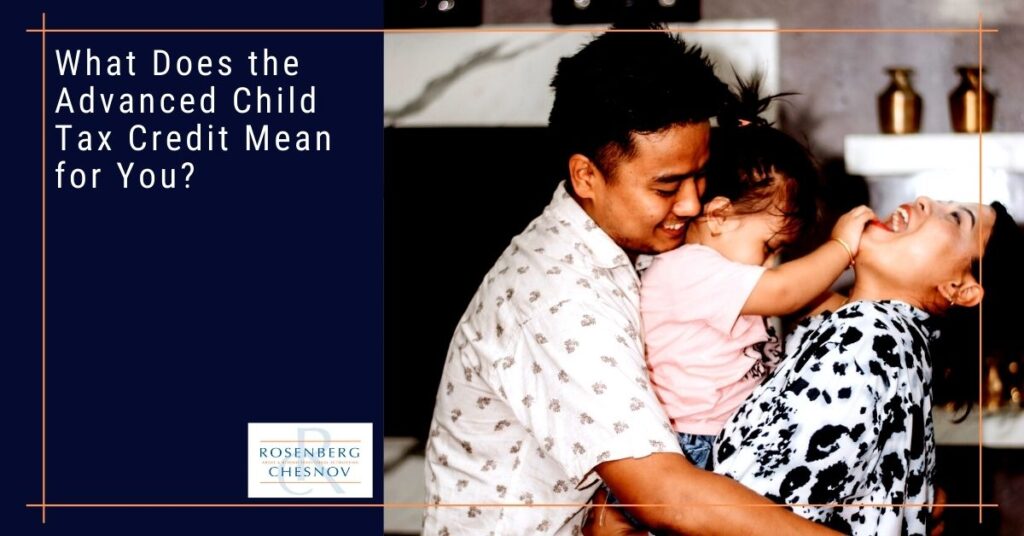

What does the Advance Child Tax Credit mean for you?
Category: COVID-19


The first program for individuals is recovery checks.
These recovery checks are one-off payments to individuals based on 2018 or 2019 income. You do not have to do anything to receive this money, it is automatic.
Here is how the program works:
Single taxpayers whose income was less than 75,000 will receive $1,200, and joint taxpayers whose income is less than 150,000 will receive $2,400. There is an additional $500 for each dependent child under 16.
Singles with an income of greater than $99,000, head of household with an income of greater than $112,000, and joint filers with an income over $198,000 do not qualify.
And then, there is a formula to figure out the payment in between. It works this way: the government will reduce the payment by 5% of the amount over the threshold.
Here is an example:
Other key details for recovery check eligibility include:
The second program includes changes to unemployment benefits.
The cares act significantly increases WHO qualifies for unemployment. So if you are an independent contractor, gig worker, freelancer, or sole proprietor, you likely qualify for unemployment.
Any employee who was furloughed or part of a layoff is eligible for state unemployment.
Here are the details:
Another change is penalty-free retirement distributions
The CARES act allows you to withdraw up to $100,000 retirement in 2020 for COVID-19-related purposes without paying a 10% penalty. The distribution will be taxable over three years unless you elect to pay it back within those three years.
This rule applies to anyone who:
The act waives minimum distribution for 2020.
And caps on charitable contributions change as well.


Category: COVID-19


Category: COVID-19


Category: Accounting
Send us a message and we will contact you as soon as possible.
Jeff Coyle, CPA, Partner of Rosenberg Chesnov, has been with the firm since 2015. He joined the firm after 20 years of business and accounting experience where he learned the value of accurate reporting, using financial information as a basis for good business decisions and the importance of accounting for management.
He is a diligent financial professional, able to manage the details and turn them into relevant business leading information. He has a strong financial background in construction, technology, consulting services and risk management. He also knows what it takes to create organizations having built teams, grown companies and designed processes for financial analysis and reporting.
His business experience includes:
Creating and preparing financial reporting, budgeting and forecasting.
Planning and preparation of GAAP and other basis financial statements.
Providing insight on financial results and providing advice based on those results.
Jeff also has a long history of helping individuals manage their taxes and plan their finances including:
Income tax planning and strategy.
Filing quarterly and annual taxes.
Audit support.
General financial and planning advice.
Prior to joining the firm in 2015, Jeff was in the private sector where he held senior financial and management positions including Controller and Chief Financial Officer. He has experience across industries, including construction, technology and professional services which gives him a deep understanding of business.
Jeff graduated from Montclair State University, he is a CPA and member of the American Institute of Certified Public Accountants, New York State Society of Certified Public Accountants and New Jersey State Society of Public Accountants.
Jody H. Chesnov, CPA, Managing Partner of Rosenberg Chesnov, has been with the firm since 2004. After a career of public accounting and general management, Jody knows the value of good financials. Clarity, decision making, and strategy all start with the facts – Jody has been revealing the facts and turning them into good business results for more than three decades.
He takes a pragmatic approach to accounting, finance and business. His work has supported many companies on their path to growth, including helping them find investors, manage scaling and overcome hurdles. His experience and passion for business reach beyond accounting and he helps businesses focus on what the numbers mean organizationally, operationally and financially.
He has a particular expertise in early-stage growth companies. His strengths lie in cutting through the noise to come up with useful, out of the box, solutions that support clients in building their businesses and realizing their larger visions.
Prior to joining the firm in 2004, Jody was in the private sector where he held senior financial and management positions including General Manager, Chief Financial Officer and Controller. He has experience across industries, which gives him a deep understanding of business.
Jody graduated with a BBA in Accounting from Baruch College, he is a CPA and member of the American Institute of Certified Public Accountants and New York State Society of Certified Public Accountants.
In addition to delivering above and beyond accounting results, Jody is a member of the NYSCPA’s Emerging Tech Entrepreneurial Committee (ETEC), Private Equity and Venture Capital Committee and Family Office Committee.
He is an angel investor through the Westchester Angels, and has served as an advisor for many startup companies and as a mentor through the Founders Institute.